Lincoln Navigator L (2012) User Manual [ru]
|
Table of Contents |
|
|
Introduction |
4 |
|
|
|
|
Instrument Cluster |
12 |
|
|
Warning lights and chimes |
12 |
Gauges |
18 |
Message center |
19 |
|
|
Entertainment Systems |
30 |
|
|
AM/FM stereo with CDX6/MP3 |
30 |
Auxiliary input jack (Line in) |
37 |
USB port |
39 |
Rear seat controls |
39 |
Satellite radio information |
45 |
Navigation system |
47 |
SYNC |
47 |
|
|
Climate Controls |
48 |
|
|
Dual automatic temperature control |
48 |
Rear window defroster |
54 |
|
|
Lights |
55 |
|
|
Headlamps |
55 |
Turn signal control |
58 |
Bulb replacement |
60 |
|
|
Driver Controls |
65 |
|
|
Windshield wiper/washer control |
65 |
Steering wheel adjustment |
67 |
Power windows |
73 |
Mirrors |
75 |
Speed control |
80 |
Moon roof |
83 |
1
2012 Navigator (nav)
Owners Guide, 1st Printing USA (fus)

Table of Contents
Locks and Security |
98 |
|
|
Keys |
98 |
Locks |
104 |
Anti-theft system |
116 |
|
|
Seating and Safety Restraints |
122 |
|
|
Seating |
122 |
Airbags |
155 |
Child restraints |
166 |
|
|
Tires, Wheels and Loading |
185 |
|
|
Tire information |
188 |
Tire inflation |
190 |
Tire Pressure Monitoring System (TPMS) |
203 |
Vehicle loading |
208 |
Trailer towing |
215 |
Recreational towing |
222 |
|
|
Driving |
223 |
|
|
Starting |
223 |
Brakes |
230 |
AdvanceTrac |
233 |
Air suspension |
240 |
Transmission operation |
242 |
Forward and reverse sensing system |
246 |
Rear-view camera system |
249 |
|
|
Roadside Emergencies |
264 |
|
|
Getting roadside assistance |
264 |
Hazard flasher control |
265 |
Fuel pump shut-off switch |
266 |
Fuses and relays |
267 |
Changing tires |
275 |
Wheel lug nut torque |
283 |
Jump starting |
285 |
Wrecker towing |
289 |
2
2012 Navigator (nav)
Owners Guide, 1st Printing USA (fus)
Table of Contents |
|
|
|
Customer Assistance |
291 |
|
|
Reporting safety defects (U.S. only) |
298 |
Reporting safety defects (Canada only) |
298 |
|
|
Cleaning |
299 |
|
|
|
|
Maintenance and Specifications |
306 |
|
|
Engine compartment |
308 |
Engine oil |
311 |
Battery |
314 |
Engine coolant |
316 |
Fuel information |
322 |
Air filter(s) |
336 |
Part numbers |
341 |
Maintenance product specifications and capacities |
342 |
Engine data |
345 |
|
|
Accessories |
349 |
|
|
|
|
Ford Extended Service Plan |
351 |
|
|
|
|
Scheduled Maintenance |
355 |
|
|
Normal scheduled maintenance and log |
360 |
|
|
Index |
376 |
|
|
All rights reserved. Reproduction by any means, electronic or mechanical including photocopying, recording or by any information storage and retrieval system or translation in whole or part is not permitted without written authorization from Ford Motor Company. Ford may change the contents without notice and without incurring obligation.
Copyright © 2011 Ford Motor Company
3
2012 Navigator (nav)
Owners Guide, 1st Printing USA (fus)
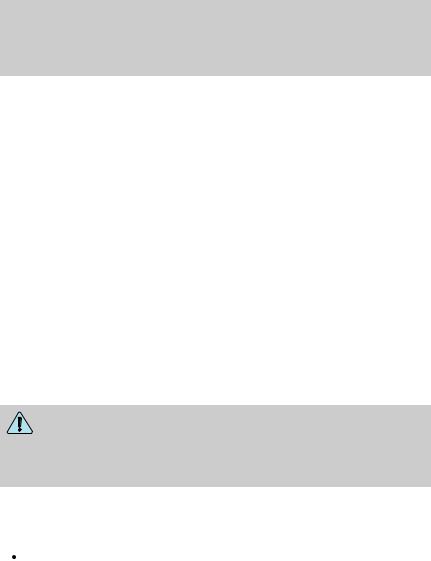
Introduction
CONGRATULATIONS
Congratulations on acquiring your new Lincoln. Please take the time to get well acquainted with your vehicle by reading this handbook. The more you know and understand about your vehicle, the greater the safety and pleasure you will derive from driving it.
For more information on Ford Motor Company and its products visit the following website:
•In the United States: www.ford.com
•In Canada: www.ford.ca
•In Mexico: www.ford.com.mx
•In Australia: www.ford.com.au
Additional owner information is given in separate publications.
This Owner’s Guide describes every option and model variant available and therefore some of the items covered may not apply to your particular vehicle. Furthermore, due to printing cycles it may describe options before they are generally available.
Remember to pass on the Owner’s Guide when reselling the vehicle. It is an integral part of the vehicle.
WARNING: Fuel pump shut-off: In the event of an accident this feature will automatically cut off the fuel supply to the
engine. It can also be activated through sudden vibration (e.g. collision when parking). To restart your vehicle, refer to Fuel pump shut-off in the Roadside Emergencies chapter.
SAFETY AND ENVIRONMENT PROTECTION
 Warning symbols in this guide
Warning symbols in this guide
How can you reduce the risk of personal injury to yourself or others? In this guide, answers to such questions are contained in comments highlighted by the warning triangle symbol. These comments should be read and observed.
4
2012 Navigator (nav)
Owners Guide, 1st Printing USA (fus)
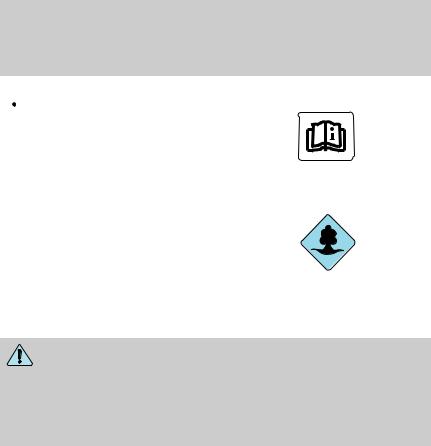
Introduction
 Warning symbols on your vehicle
Warning symbols on your vehicle
When you see this symbol, it is imperative that you consult the relevant section of this guide before touching or attempting adjustment of any kind.
Protecting the environment
We must all play our part in protecting the environment. Correct
vehicle usage and the authorized disposal of waste, cleaning and
lubrication materials are significant
steps towards this aim. Information in this respect is highlighted in this guide with the tree symbol.
CALIFORNIA Proposition 65 Warning
WARNING: Engine exhaust, some of its constituents, and certain vehicle components contain or emit chemicals known to
the State of California to cause cancer and birth defects or other reproductive harm. In addition, certain fluids contained in vehicles and certain products of component wear contain or emit chemicals known to the State of California to cause cancer and birth defects or other reproductive harm.
PERCHLORATE MATERIAL
Certain components of this vehicle such as airbag modules, seat belt pretensioners, and button cell batteries may contain Perchlorate Material
– Special handling may apply for service or vehicle end of life disposal. See www.dtsc.ca.gov/hazardouswaste/perchlorate.
BREAKING-IN YOUR VEHICLE
Your vehicle does not need an extensive break-in. Try not to drive continuously at the same speed for the first 1,000 miles (1,600 km) of new vehicle operation. Vary your speed frequently in order to give the moving parts a chance to break in.
Drive your new vehicle at least 1,000 miles (1,600 km) before towing a trailer. For more detailed information about towing a trailer, refer to
Trailer towing in the Tires, Wheels and Loading chapter.
5
2012 Navigator (nav)
Owners Guide, 1st Printing USA (fus)
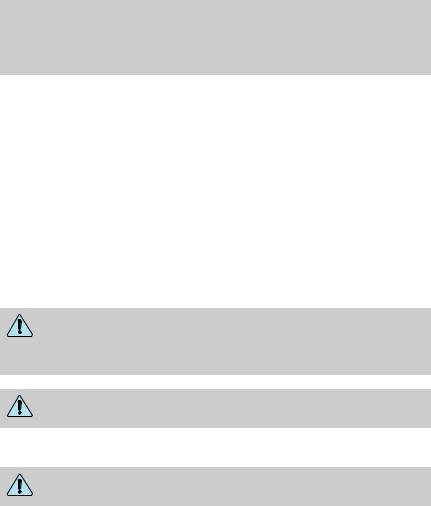
Introduction
Do not add friction modifier compounds or special break-in oils since these additives may prevent piston ring seating. See Engine oil in the Maintenance and Specifications chapter for more information on oil usage.
SPECIAL NOTICES
New Vehicle Limited Warranty
For a detailed description of what is covered and what is not covered by your vehicle’s New Vehicle Limited Warranty, refer to the Warranty Guide that is provided to you along with your Owner’s Guide.
Special instructions
For your added safety, your vehicle is fitted with sophisticated electronic controls.
WARNING: Please read the section Airbag Supplemental Restraint System (SRS) in the Seating and Safety Restraints
chapter. Failure to follow the specific warnings and instructions could result in personal injury.
WARNING: Front seat mounted rear-facing child or infant seats should NEVER be placed in front of an active passenger airbag.
Notice to owners of pickup trucks and utility type vehicles
WARNING: Utility vehicles have a significantly higher rollover rate than other types of vehicles.
Before you drive your vehicle, please read this Owner’s Guide carefully. Your vehicle is not a passenger car. As with other vehicles of this type, failure to operate this vehicle correctly may result in loss of vehicle control, vehicle rollover, personal injury or death.
Using your vehicle with a snowplow
Do not use this vehicle for snowplowing.
Your vehicle is not equipped with a snowplowing package.
6
2012 Navigator (nav)
Owners Guide, 1st Printing USA (fus)

Introduction
DATA RECORDING
Service Data Recording
Service data recorders in your vehicle are capable of collecting and storing diagnostic information about your vehicle. This potentially includes information about the performance or status of various systems and modules in the vehicle, such as engine, throttle, steering or brake systems. In order to properly diagnose and service your vehicle, Ford Motor Company, Ford of Canada, and service and repair facilities may access or share among them vehicle diagnostic information received through a direct connection to your vehicle when diagnosing or servicing your vehicle. For U.S. only (if equipped), if you choose to use the SYNC Vehicle Health Report, you consent that certain diagnostic information may also be accessed electronically by Ford Motor Company and Ford authorized service facilities, and that the diagnostic information may be used for any purpose. See your SYNC supplement for more information.
Event Data Recording
This vehicle is equipped with an event data recorder (EDR). The main purpose of an EDR is to record, in certain crash or near crash-like situations, such as an airbag deployment or hitting a road obstacle; this data will assist in understanding how a vehicle’s systems performed. The EDR is designed to record data related to vehicle dynamics and safety systems for a short period of time, typically 30 seconds or less. The EDR in this vehicle is designed to record such data as:
•How various systems in your vehicle were operating;
•Whether or not the driver and passenger seatbelts were buckled/fastened;
•How far (if at all) the driver was depressing the accelerator and/or the brake pedal; and
•How fast the vehicle was travelling; and
•Where the driver was positioning the steering wheel.
This data can help provide a better understanding of the circumstances in which crashes and injuries occur.
Note: EDR data is recorded by your vehicle only if a non-trivial crash situation occurs; no data is recorded by the EDR under normal driving conditions and no personal data or information (e.g., name, gender, age, and crash location) is recorded (see
7
2012 Navigator (nav)
Owners Guide, 1st Printing USA (fus)

Introduction
limitations regarding 911 Assist and Traffic, directions and Information privacy below). However, parties, such as law enforcement, could combine the EDR data with the type of personally identifying data routinely acquired during a crash investigation.
To read data recorded by an EDR, special equipment is required, and access to the vehicle or the EDR is needed. In addition to the vehicle manufacturer, other parties, such as law enforcement, that have such special equipment, can read the information if they have access to the vehicle or the EDR. Ford Motor Company and Ford of Canada do not access event data recorder information without obtaining consent, unless pursuant to court order or where required by law enforcement, other government authorities or other third parties acting with lawful authority. Other parties may seek to access the information independently of Ford Motor Company and Ford of Canada.
Note: Including to the extent that any law pertaining to Event Data Recorders applies to SYNC or its features, please note the following: Once 911 Assist (if equipped) is enabled (set ON), 911 Assist may, through any paired and connected cell phone, disclose to emergency services that the vehicle has been in a crash involving the deployment of an airbag or, in certain vehicles, the activation of the fuel pump shut-off. Certain versions or updates to 911 Assist may also be capable of being used to electronically or verbally provide to 911 operators the vehicle location (such as latitude and longitude), and/or other details about the vehicle or crash or personal information about the occupants to assist 911 operators to provide the most appropriate emergency services. If you do not want to disclose this information, do not activate the 911 Assist feature. See your SYNC supplement for more information.
Additionally, when you connect to Traffic, Directions and Information (if equipped, U.S. only) the service uses GPS technology and advanced vehicle sensors to collect the vehicle’s current location, travel direction, and speed (“vehicle travel information”) only to help provide you with the directions, traffic reports, or business searches your request. If you do not want Ford or its vendors to receive this information, do not activate the service. Ford Motor Company and the vendors it uses to provide you with this information do not store your vehicle travel information. For more information, see Traffic, Directions and Information, Terms and Conditions. See your SYNC supplement for more information.
8
2012 Navigator (nav)
Owners Guide, 1st Printing USA (fus)

Introduction
CELL PHONE USE
The use of Mobile Communications Equipment has become increasingly important in the conduct of business and personal affairs. However, drivers must not compromise their own or others’ safety when using such equipment. Mobile Communications can enhance personal safety and security when appropriately used, particularly in emergency situations. Safety must be paramount when using mobile communications equipment to avoid negating these benefits.
Mobile Communication Equipment includes, but is not limited to, cellular phones, pagers, portable email devices, text messaging devices and portable two-way radios.
WARNING: Driving while distracted can result in loss of vehicle control, accident and injury. Ford strongly recommends that you
use extreme caution when using any device or feature that may take your focus off the road. Your primary responsibility is the safe operation of your vehicle.
We recommend against the use of any handheld device while driving and that you comply with all applicable laws.
EXPORT UNIQUE (NON–UNITED STATES/CANADA) VEHICLE SPECIFIC INFORMATION
For your particular global region, your vehicle may be equipped with features and options that are different from the features and options that are described in this Owner’s Guide. A market unique supplement may be supplied that complements this book. By referring to the market unique supplement, if provided, you can properly identify those features, recommendations and specifications that are unique to your vehicle. This Owner’s Guide is written primarily for the U.S. and Canadian Markets. Features or equipment listed as standard may be different on units built for Export. Refer to this Owner’s Guide for all other required information and warnings.
9
2012 Navigator (nav)
Owners Guide, 1st Printing USA (fus)
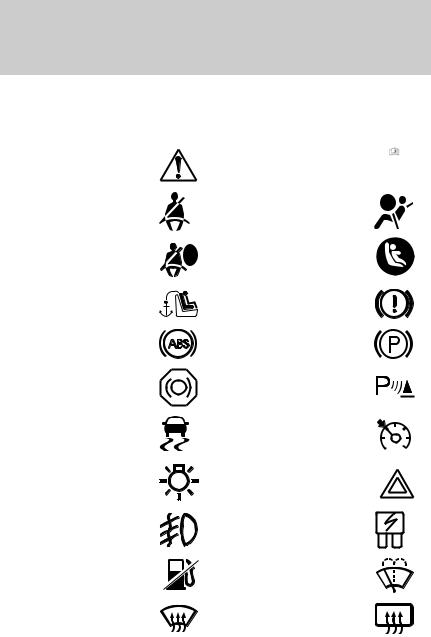
Introduction
These are some of the symbols you may see on your vehicle.
Vehicle Symbol Glossary |
||
Safety Alert |
See Owner’s Guide |
|
Fasten Safety Belt |
Airbag - Front |
|
Airbag - Side |
Child Seat Lower |
|
Anchor |
||
|
||
Child Seat Tether |
Brake System |
|
Anchor |
||
|
||
Anti-Lock Brake System |
Parking Brake System |
|
Brake Fluid - |
Parking Aid System |
|
Non-Petroleum Based |
||
|
||
Stability Control System |
Speed Control |
|
Master Lighting Switch |
Hazard Warning Flasher |
|
Fog Lamps-Front |
Fuse Compartment |
|
Fuel Pump Reset |
Windshield Wash/Wipe |
|
Windshield |
Rear Window |
|
Defrost/Demist |
Defrost/Demist |
|
10 |
|
|
2012 Navigator (nav)
Owners Guide, 1st Printing USA (fus)
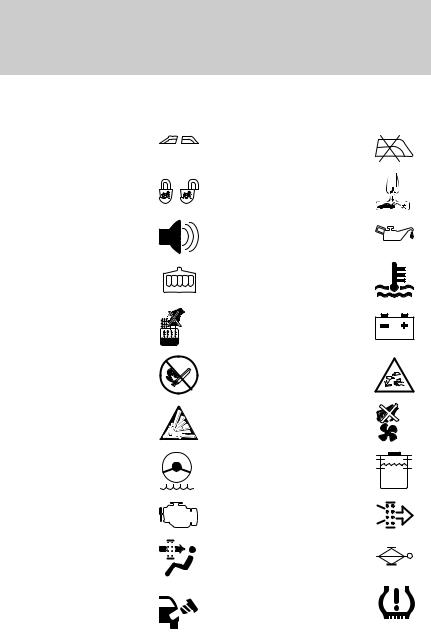
Introduction
Vehicle Symbol Glossary
Power Windows |
Power Window Lockout |
|
Front/Rear |
||
|
||
Child Safety Door |
Interior Luggage |
|
Lock/Unlock |
Compartment Release |
|
Panic Alarm |
Engine Oil |
|
Engine Coolant |
Engine Coolant |
|
Temperature |
||
|
||
Do Not Open When Hot |
Battery |
|
Avoid Smoking, Flames, |
Battery Acid |
|
or Sparks |
||
|
||
Explosive Gas |
Fan Warning |
|
Power Steering Fluid |
Maintain Correct Fluid |
|
Level |
||
|
||
Service Engine Soon |
Engine Air Filter |
|
Passenger Compartment |
Jack |
|
Air Filter |
||
|
||
Check Fuel Cap |
Low Tire Pressure |
|
Warning |
||
|
MAX
MIN
11
2012 Navigator (nav)
Owners Guide, 1st Printing USA (fus)
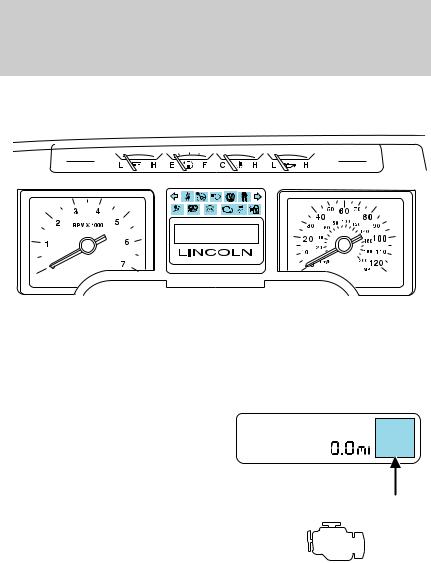
Instrument Cluster
WARNING LIGHTS AND CHIMES
Instrument cluster shown in standard measure; metric similar.
Warning lights and gauges can alert you to a vehicle condition that may become serious enough to cause expensive repairs. A warning light may illuminate when a problem exists with one of your vehicle’s functions.
Many lights will illuminate when you start your vehicle to make sure the bulb works. If any light remains on after starting the vehicle, refer to the respective system warning light for additional information.
Note: Some warning lights are reconfigurable telltale (RTT) indicator lights and will illuminate in the message center. These lights function the same as the other warning lights.
Service engine soon: The  indicator light illuminates when the
indicator light illuminates when the
ignition is first turned to the on position to check the bulb and to
indicate whether the vehicle is ready for Inspection/Maintenance (I/M) testing. Normally, the “service engine soon” light will stay on until the engine is cranked, then turn itself off if no malfunctions are present.
However, if after 15 seconds the “service engine soon” light blinks eight times, it means that the vehicle is not ready for I/M testing. See the
Readiness for Inspection/Maintenance (I/M) testing in the Maintenance and Specifications chapter.
12
2012 Navigator (nav)
Owners Guide, 1st Printing USA (fus)
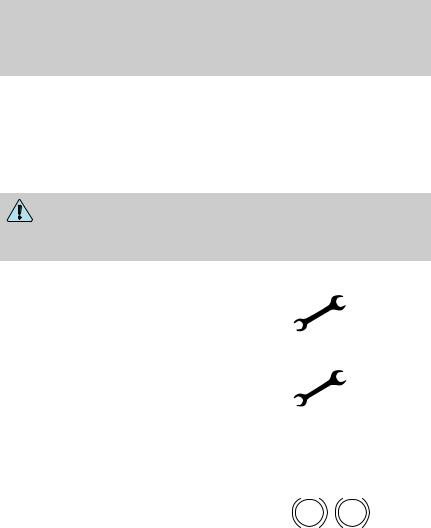
Instrument Cluster
Solid illumination after the engine is started indicates the on-board diagnostics system (OBD-II) has detected a malfunction. Refer to
On-board diagnostics (OBD-II) in the Maintenance and Specifications chapter. If the light is blinking, engine misfire is occurring which could damage your catalytic converter. Drive in a moderate fashion (avoid heavy acceleration and deceleration) and have your vehicle serviced immediately by your authorized dealer.
WARNING: Under engine misfire conditions, excessive exhaust temperatures could damage the catalytic converter, the fuel
system, interior floor coverings or other vehicle components, possibly causing a fire.
Powertrain malfunction/reduced power (RTT) (if equipped):
Displays when the vehicle has defaulted to a “limp-home”
operation. Report the fault to a dealer at the earliest opportunity.
Check 4X4 (RTT) (if equipped):
Displays with the message CHECK 4X4 when a four-wheel drive fault is present.
When this warning appears have your vehicle serviced by your authorized dealer.
Refer to the Driving chapter for more information on four-wheel drive operation.
Brake system warning light: To |
! |
P |
confirm the brake system warning |
||
light is functional, it will |
BRAKE |
|
momentarily illuminate when the |
||
ignition is turned to the on position
when the engine is not running, or in a position between on and start, or by applying the parking brake when the ignition is turned to the on position. If the brake system warning light does not illuminate at this time, seek service immediately from your authorized dealer. Illumination after releasing the parking brake indicates low brake fluid level and the brake system should be inspected immediately by your authorized dealer.
13
2012 Navigator (nav)
Owners Guide, 1st Printing USA (fus)

Instrument Cluster
WARNING: Driving a vehicle with the brake system warning light on is dangerous. A significant decrease in braking
performance may occur. It will take you longer to stop the vehicle. Have the vehicle checked by your authorized dealer. Driving extended distances with the parking brake engaged can cause brake failure and the risk of personal injury.
Anti-lock brake system: If the
ABS light stays illuminated or ABS continues to flash, a malfunction has
been detected, have the system serviced immediately by your
authorized dealer. Normal braking is still functional unless the brake warning light also is illuminated.
Airbag readiness: If this light fails to illuminate when the ignition is turned to on, continues to flash or remains on, have the system
serviced immediately by your authorized dealer. A chime will sound when there is a malfunction in the indicator light.
Safety belt: Reminds you to fasten
your safety belt. A Belt-Minder chime will also sound to remind you
to fasten your safety belt. Refer to the Seating and Safety Restraints
chapter to activate/deactivate the Belt-Minder chime feature.
Charging system (RTT):
Illuminates when the battery is not charging properly. If it stays on
while the engine is running, there
may be a malfunction with the charging system. Contact your authorized dealer as soon as possible. This indicates a problem with the electrical system or a related component.
Anti-theft system: Flashes when the SecuriLock Passive Anti-theft System has been activated.
14
2012 Navigator (nav)
Owners Guide, 1st Printing USA (fus)
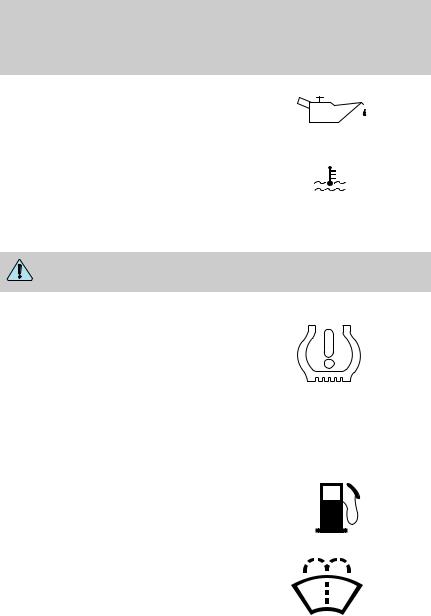
Instrument Cluster
Engine oil pressure (RTT):
Displays when the oil pressure falls below the normal range. Refer to
Engine oil in the Maintenance and Specifications chapter.
Engine coolant temperature (RTT): Displays when the engine coolant temperature is high. Stop
the vehicle as soon as safely possible, switch off the engine and let it cool. Refer to Engine coolant in the Maintenance and Specifications chapter.
WARNING: Never remove the coolant reservoir cap while the engine is running or hot.
Low tire pressure warning:
Illuminates when your tire pressure is low. If the light remains on at start up or while driving, the tire
pressure should be checked. Refer
to Inflating your tires in the Tires, Wheels and Loading chapter. When the ignition is first turned to on, the light will illuminate for three seconds to ensure the bulb is working. If the light does not turn on or begins to flash, have the system inspected by your authorized dealer. For more information on this system, refer to Tire pressure monitoring system (TPMS) in the Tires, Wheels and Loading chapter.
Low fuel (RTT) (if equipped):
Displays when the fuel level in the fuel tank is at or near empty (refer to Fuel gauge in this chapter).
Low washer fluid (RTT) (if equipped): Displays when the windshield washer fluid is low.
15
2012 Navigator (nav)
Owners Guide, 1st Printing USA (fus)
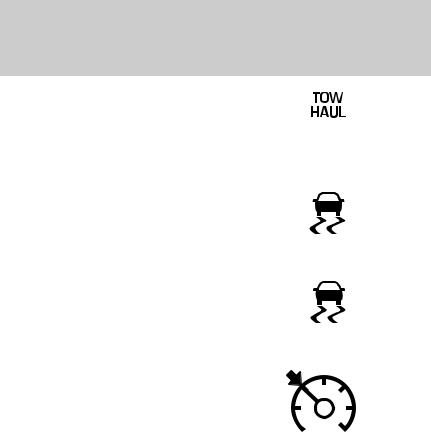
Instrument Cluster
Transmission Tow/Haul Feature (RTT): Illuminates when the Tow/Haul feature has been activated. Refer to the Driving
chapter for transmission function and operation. If the light flashes steadily, have the system serviced immediately, damage to the transmission could occur.
AdvanceTrac /Traction control (if equipped): Displays when the AdvanceTrac /Traction control is active. If the light remains on, have
the system serviced immediately, refer to the Driving chapter for more information.
AdvanceTrac /Traction control |
|
off light (if equipped): Illuminates |
|
when AdvanceTrac /Traction control |
|
has been disabled by the driver. |
OFF |
Refer to the Driving chapter for |
|
more information. |
|
Speed control: Illuminates when the speed control is activated. Turns off when the speed control system is deactivated.
4X2 (RTT) (if equipped):
Displays momentarily when
two-wheel drive high is selected. If 4x2 the light fails to display when the
ignition is turned on, or remains on,
have the system serviced immediately by your authorized dealer.
Four wheel drive (RTT) (if |
4x4 |
equipped): Displays when four-wheel drive is engaged. If the
light fails to illuminate when the ignition is turned on, or remains on, have the system serviced immediately by your authorized dealer.
16
2012 Navigator (nav)
Owners Guide, 1st Printing USA (fus)
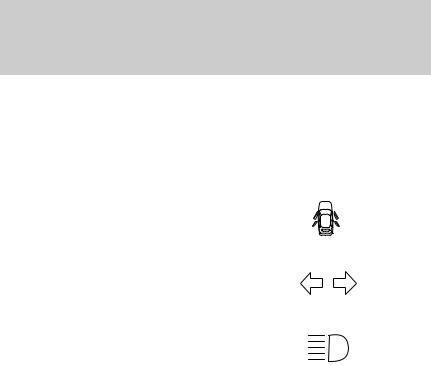
17
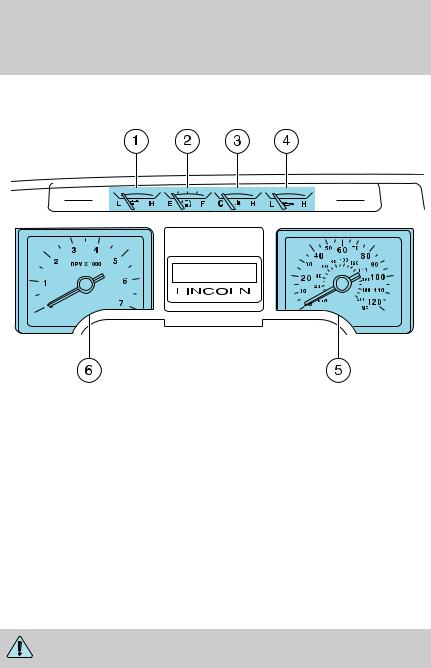
Instrument Cluster
GAUGES
Instrument cluster shown in standard measure; metric similar.
1.Battery voltage gauge: Indicates the battery voltage when the ignition is in the on position. If the pointer moves and stays outside the normal operating range, have the vehicle’s electrical system checked by your authorized dealer as soon as possible.
2.Fuel gauge: Indicates approximately how much fuel is left in the fuel tank (when the ignition is in the on position). The fuel gauge may vary slightly when the vehicle is in motion or on a grade. The fuel icon and arrow indicates which side of the vehicle the fuel filler door is located.
Refer to Filling the tank in the Maintenance and Specifications chapter for more information.
3. Engine coolant temperature gauge: Indicates engine coolant temperature. At normal operating temperature, the needle will be in the normal range (between H and C). If it enters the red section, the engine is overheating. Stop the vehicle as soon as safely possible, switch off the engine and let the engine cool.
WARNING: Never remove the coolant reservoir cap while the engine is running or hot.
18
2012 Navigator (nav)
Owners Guide, 1st Printing USA (fus)

Instrument Cluster
4.Engine oil pressure gauge: Indicates engine oil pressure. The needle should stay in the normal operating range (between L and H). If the needle falls below the normal range, stop the vehicle, turn off the engine and check the engine oil level. Add oil if needed. If the oil level is correct, have your vehicle checked at your authorized dealer.
5.Speedometer: Indicates the current vehicle speed.
6.Tachometer: Indicates the engine speed in revolutions per minute. Driving with your tachometer pointer continuously at the top of the scale may damage the engine.
Odometer and trip odometer: The odometer is displayed in the message center and registers the total accumulated distance the vehicle has traveled. For trip odometer, refer to Message center in this chapter.
MESSAGE CENTER
Your vehicle’s message center is capable of monitoring many vehicle systems and will alert you to potential vehicle problems and various conditions with an informational message followed by a long indicator chime.
The message center display is located in the instrument cluster.
Info
Press the INFO button repeatedly to cycle through the following features:
TRIP A/B
Registers the distance of individual journeys. Press and release INFO button until the A or B trip appears in the display (this represents the trip mode). Press and hold the RESET button to reset.
Refer to UNITS later in this section to switch the display from Metric to English.
XX°F (XX°C)
This displays the outside air temperature. Press and hold INFO for two seconds to display the outside temperature. To switch from a blank display to the temperature display, hold INFO for two seconds until the temperature is seen in the display. To switch the temperature display to compass display, hold INFO until the compass heading is seen in the display
19
2012 Navigator (nav)
Owners Guide, 1st Printing USA (fus)

Instrument Cluster
MYKEY MILES (km) (if programmed)
For more information, refer to MyKey in the Locks and Security chapter.
MILES (km) TO E
This displays an estimate of approximately how far you can drive with the fuel remaining in your tank under normal driving conditions. Remember to turn the ignition off when refueling to allow this feature to correctly detect the added fuel.
LOW FUEL LEVEL will display when you have approximately 50 miles (80 km), to empty. Press RESET to clear this warning message. It will return at approximately 25 miles (40 km), 10 miles (16 km) and 0 miles (0 km) miles to empty.
Distance to empty is calculated using a running average fuel economy, which is based on your recent driving history of 500 miles (800 km). This value is not the same as the average fuel economy display. The running average fuel economy is re-initialized to a factory default value if the battery is disconnected.
AVG MPG (L/100km)
Average fuel economy displays your average fuel economy in miles/gallon or liters/100 km.
If you calculate your average fuel economy by dividing distance traveled by gallons of fuel used (liters of fuel used by 100 kilometers traveled), your figure may be different than displayed for the following reasons:
•Your vehicle was not perfectly level during fill-up
•Differences in the automatic shut-off points on the fuel pumps at service stations
•Variations in top-off procedure from one fill-up to another
•Rounding of the displayed values to the nearest 0.1 gallon (liter) To determine your average highway fuel economy, do the following:
1.Drive the vehicle at least 5 miles (8 km) with the speed control system engaged to display a stabilized average.
2.Record the highway fuel economy for future reference.
It is important to press RESET (press and hold RESET for two seconds in order to reset the function) after setting the speed control to get accurate highway fuel economy readings.
For more information refer to Essentials of good fuel economy in the
Maintenance and Specifications chapter. 20
2012 Navigator (nav)
Owners Guide, 1st Printing USA (fus)

Instrument Cluster
MPG (L/km)

This displays instantaneous fuel economy as a bar graph ranging from ↓ poor economy to ↑ excellent economy.
Your vehicle must be moving to calculate instantaneous fuel economy. When your vehicle is not moving, this function shows ↓, one or no bars illuminated. Instantaneous fuel economy cannot be reset.
TIMER
Timer displays the trip elapsed drive time. To operate, do the following:
1.Press and release RESET in order to start the timer.
2.Press and release RESET to pause the timer.
3.Press and hold RESET until the timer resets.
System check and vehicle feature customization
Press the SETUP button repeatedly to cycle the message center through the following features:
RESET FOR SYSTEM CHECK
When this message appears, press the RESET button and the message center will begin to cycle through the following systems and provide a status of the item if needed.
Note: Some systems show a message only if a condition is present.
1.OIL LIFE
2.CHARGING SYSTEM
3.WASHER FLUID LEVEL
4.DOOR STATUS
5.LIFTGATE/GLASS
6.BRAKE SYSTEM
7.TIRE PRESSURE
8.AIR SUSPENSION SYSTEM
9.FUEL LEVEL
10.MYKEY MILES (if programmed)
11.MYKEY(S) PROGRAMMED
12.ADMIN KEYS PROGRAMMED
21
2012 Navigator (nav)
Owners Guide, 1st Printing USA (fus)

Instrument Cluster
OIL LIFE
This displays the remaining oil life.
An oil change is required whenever indicated by the message center and according to the recommended maintenance schedule. USE ONLY RECOMMENDED ENGINE OILS.
To reset the oil monitoring system to 100% after each oil change perform the following:
1.Press and release SETUP to display “OIL LIFE XXX% HOLD RESET = NEW”.
2.Press and hold RESET for two seconds and release to reset the oil life to 100%.
Note: To change oil life 100% value to another value, proceed to Step 3.
3. Once “OIL LIFE SET TO XXX%” is displayed, release and press RESET to change the Oil Life Start Value. Each release and press will reduce the value by 10%.
UNITS
Displays the current units English or Metric.
Press the RESET button to change from English to Metric.
AUTOLAMP (SEC)
This feature keeps your headlights on for up to three minutes after the ignition is switched off.
Press the RESET button to select the new Autolamp delay values of 0, 10, 20, 30, 60, 90, 120 or 180 seconds.
AUTOLOCK
This feature automatically locks all vehicle doors when the vehicle is shifted into any gear, putting the vehicle in motion.
Press the RESET button to turn autolock on or off.
AUTOUNLOCK
This feature automatically unlocks all vehicle doors when the driver’s door is opened within 10 minutes of the ignition being turned off.
Press the RESET button to turn autounlock on or off.
RUNNING BOARDS (if equipped)
This feature automatically deploys the side running boards for easy entry/exit from the vehicle or for cleaning.
Press the RESET button to select the running boards setting as follows:
•AUTO: the running boards will automatically deploy when a door is opened and automatically retract when the door is closed,
22
2012 Navigator (nav)
Owners Guide, 1st Printing USA (fus)

Instrument Cluster
•OUT: the running boards will remain deployed regardless of the doors being open/closed. This setting can be used when washing the vehicle, or accessing the roof rack. The running boards will stow and enter AUTO mode when the vehicle speed exceeds 5 mph (8 km/h),
•OFF: the running boards will remain IN regardless of the doors being open/closed.
POWER LIFTGATE
This feature allows users to open/close the rear liftgate at the touch of a button.
Press the RESET button to turn the power liftgate on or off. If disabled, the outside release handle and the rear cargo area control button are off. The instrument panel button will continue to function the liftgate in power mode.
EASY ENTRY
This feature automatically moves the driver’s seat backwards for easy exit/entry from the vehicle.
Press the RESET button to turn the easy entry/exit seat on or off.
AIR SUSPENSION
Before disabling the air suspension, make sure the liftgate and liftgate glass are in the closed position.
With the vehicle in P (Park), press RESET to turn the air suspension off or on.
REAR PARK AID
This feature sounds a warning tone to warn the driver of obstacles near the rear bumper, and functions only when R (Reverse) gear is selected.
To disable/enable rear park aid, press RESET when reaching this menu from the setup sequence or put the vehicle in R (Reverse) and press RESET.
FRONT PARK AID
This feature sounds a warning tone to warn the driver of obstacles near the front bumper.
To disable/enable front park aid, press RESET when reaching this menu from the setup sequence or put the vehicle in D (DRIVE) and press RESET.
TRAILER SWAY (if equipped)
This feature uses the electronic stability control to mitigate trailer sway,
Press the RESET button to turn trailer sway on or off.
23
2012 Navigator (nav)
Owners Guide, 1st Printing USA (fus)

Instrument Cluster
CREATE MYKEY / CLEAR MYKEY / MYKEY SETUP
For more information refer to MyKey in the Locks and Security chapter.
COMPASS
The compass heading is displayed as one of N, NE, E, SE, S, SW, W and NW in the message center display.
The compass reading may be affected when you drive near large buildings, bridges, power lines and powerful broadcast antenna. Magnetic or metallic objects placed in, on or near the vehicle may also affect compass accuracy.
Usually, when something affects the compass readings, the compass will correct itself after a few days of operating your vehicle in normal conditions. If the compass still appears to be inaccurate, a manual calibration may be necessary. Refer to Compass zone/calibration adjustment.
Most geographic areas (zones) have a magnetic north compass point that varies slightly from the northerly direction on maps. This variation is four degrees between adjacent zones and will become noticeable as the vehicle crosses multiple zones. A correct zone setting will eliminate this error. Do the following to set the proper zone:
Compass zone/calibration adjustment
1. Determine your magnetic zone by referring to the zone map.
2. |
Turn ignition to the on position. |
3 |
2 |
1 |
15 |
3. |
Start the engine. |
4 |
|
|
14 |
4. |
Press SETUP to reach the reset |
|
|
|
|
|
|
|
13 |
||
for zone setting screen. |
5 |
|
|
12 |
|
5. |
Press and hold RESET until the |
|
|
|
|
|
|
|
|
||
message center display prompts you |
|
|
|
|
|
to reset the current zone setting. |
|
|
6 |
7 8 9 1011 |
|
Press RESET. |
|
|
|
|
|
6.Press and release RESET until the message center display changes to show the current zone setting (XX).
7.Press and release the RESET button repeatedly until the correct zone setting for your geographic location is displayed on the message center. The range of zone values are from 1 to 15 and “wraps” back to 1.
24
2012 Navigator (nav)
Owners Guide, 1st Printing USA (fus)

Instrument Cluster
8. To exit the zone setting mode, and to “lock in” your change:
•press and release SETUP or,
•press INFO to exit or,
•wait four seconds and the zone will be “locked in”.
Perform compass calibration in an open area free from steel structures and high voltage lines. For optimum calibration, turn off all electrical accessories (heater/air conditioning, wipers, etc.) and make sure all vehicle doors are shut.
9.Press RESET to start the compass calibration function.
10.Slowly drive the vehicle in a circle (less than 3 mph [5 km/h]) until the CIRCLE SLOWLY TO CALIBRATE display changes to CALIBRATION COMPLETED. It will take up to five circles to complete calibration.
11.The compass is now calibrated.
Note: If the RESET button is pressed or three minutes has expired, the display will go back to the INFO menu and will show CAL instead of the compass heading until the compass is calibrated.
ENGLISH / FRENCH / SPANISH RESET FOR NEW
Allows you to choose which language the message center will display in. Selectable languages are English, Spanish, or French.
Press RESET to cycle through each of the language choices.
Press and hold RESET for two seconds to set the language choice.
System warnings
System warnings alert you to possible problems or malfunctions in your vehicle’s operating systems.
In the event of a multiple warning situation, the message center will cycle the display to show all warnings by displaying each one for four seconds.
The message center will display the last selected feature if there are no more warning messages.
Types of messages and warnings:
•Some messages will appear briefly to inform you of something you may need to take action on or be informed of.
•Some messages will appear once and then again when the vehicle is restarted.
25
2012 Navigator (nav)
Owners Guide, 1st Printing USA (fus)

Instrument Cluster
•Some messages will reappear after clearing or being reset if a problem or condition is still present and needs your attention.
•Some messages can be acknowledged and reset by pressing RESET. This allows you to use the full message center functionality by clearing the message.
DRIVER DOOR AJAR — Displayed when the driver door is not completely closed.
PASSENGER DOOR AJAR — Displayed when the passenger door is not completely closed.
REAR LEFT DOOR AJAR — Displayed when the rear left door is not completely closed.
REAR RIGHT DOOR AJAR — Displayed when the rear right door is not completely closed.
LIFTGATE / GLASS AJAR — Displayed when the liftgate or liftgate glass is not completely closed.
CHECK CHARGING SYSTEM — Displayed when the electrical system is not maintaining proper voltage when the engine is running. If you are operating electrical accessories when the engine is idling at a low speed, turn off as many of the electrical loads as soon as possible. If the warning stays on or comes on when the engine is operating at normal speeds, contact your authorized dealer as soon as possible.
CHECK FUEL FILL INLET — Displayed when the fuel fill inlet may not be properly closed. Refer to Easy Fuel “no cap” fuel system in the
Maintenance and Specifications chapter.
TIRE PRESSURE SENSOR FAULT — Displayed when a tire pressure sensor is malfunctioning, or your spare tire is in use. For more information on how the system operates under these conditions, refer to
Understanding Your Tire Pressure Monitoring System (TPMS) in the
Tires, Wheels and Loading chapter. If the warning stays on or continues to come on, contact your authorized dealer as soon as possible.
LOW TIRE PRESSURE — Displayed when one or more tires on your vehicle have low tire pressure. Refer to Inflating your tires in the Tires, Wheels and Loading chapter.
26
2012 Navigator (nav)
Owners Guide, 1st Printing USA (fus)

Instrument Cluster
TIRE PRESSURE MONITOR FAULT — Displayed when the Tire Pressure Monitoring System is malfunctioning. If the warning stays on or continues to come on, contact your authorized dealer as soon as possible.
AIR SUSPENSION OFF (if equipped) — Displayed when the air suspension is off. For more information, refer to Air suspension system in the Driving chapter.
BRAKE FLUID LEVEL LOW — Indicates the brake fluid level is low and the brake system should be inspected immediately. Refer to Brake fluid in the Maintenance and Specifications chapter.
WASHER FLUID LEVEL LOW — Indicates the washer fluid reservoir is less than one quarter full. Check the washer fluid level. Refer to
Windshield washer fluid in the Maintenance and Specifications chapter.
ENGINE OIL CHANGE SOON — Displayed when the engine oil life remaining is 10% or less. When oil life left is between 10% and 0%, the XX% OIL LIFE CHANGE SOON message will be displayed.
OIL CHANGE REQUIRED — Displayed when the oil life left reaches 0%.
CHECK AIR SUSPENSION (if equipped) — Displayed when the air suspension system is not operating properly. If this message is displayed while driving, pull off the road as soon as safely possible. For more information, refer to Air suspension system in the Driving chapter.
CHECK BRAKE SYSTEM — Displayed when the braking system is not operating properly. If the warning stays on or continues to come on, contact your authorized dealer as soon as possible.
CHECK PARK AID (if equipped) — Displayed when the transmission is in R (Reverse). Refer to Forward and reverse sensing system in the
Driving chapter.
XXX MILES TO E FUEL LEVEL LOW — Displayed as an early reminder of a low fuel condition.
PARK BRAKE ENGAGED — Displayed when the parking brake is set, the engine is running and the vehicle is driven more than 3 mph
(5 km/h). If the warning stays on after the parking brake is released, contact your authorized dealer as soon as possible.
27
2012 Navigator (nav)
Owners Guide, 1st Printing USA (fus)

Instrument Cluster
TRAILER SWAY REDUCE SPEED (if equipped) — Displayed when the trailer sway control has detected trailer sway. For more information, refer to the Driving chapter for more information.
4X4 SHIFT IN PROGRESS — Displayed when the 4X4 system is making a shift. For more information, refer to Control trac four-wheel drive (4X4) operation in the Driving chapter.
FOR 4X4 LOW SLOW TO 3 MPH (if equipped) — Displayed when 4X4 LOW is selected while the vehicle is moving. For more information, refer to Control trac four-wheel drive (4X4) operation in the Driving chapter.
FOR 4X4 LOW SHIFT TO N (if equipped) — Displayed when 4X4 LOW is selected and the vehicle is stopped. For more information, refer to Control trac four-wheel drive (4X4) operation in the Driving chapter.
TO EXIT 4X4 LOW SLOW TO 3 MPH (if equipped) — Displayed when 2WD is selected while the vehicle is operating in 4X4 LOW. For more information, refer to Control trac four-wheel drive (4X4) operation in the Driving chapter.
TO EXIT 4X4 LOW SHIFT TO N (if equipped) — Displayed when 2WD is selected while the vehicle has been stopped in 4X4 LOW. For more information, refer to Control trac four-wheel drive (4X4) operation in the Driving chapter.
MYKEY ACTIVE DRIVE SAFELY — Displayed at startup when MyKey is in use. Refer to MyKey in the Locks and Security chapter for more information.
KEY COULD NOT PROGRAM — Displayed when an attempt is made to program a spare key using two existing MyKeys. Refer to MyKey in the Locks and Security chapter for more information.
VEHICLE SPEED 80 MPH MAX — Displayed when a MyKey is in use and the Admin has enabled the MyKey speed limit and the vehicle speed is 80 mph (130 km/h). Refer to MyKey in the Locks and Security chapter for more information.
SPEED LIMITED TO 80 MPH — Displayed when starting the vehicle and MyKey is in use and the MyKey speed limit is on. Refer to MyKey in the Locks and Security chapter for more information.
28
2012 Navigator (nav)
Owners Guide, 1st Printing USA (fus)

Instrument Cluster
CHECK SPEED DRIVE SAFELY — Displayed when a MyKey is in use and the optional setting is on and the vehicle exceeds a preselected speed. Refer to MyKey in the Locks and Security chapter for more information.
VEHICLE NEAR TOP SPEED — Displayed when a MyKey is in use and the MyKey speed limit is on and the vehicle speed is approaching 80 mph (130 km/h). Refer to MyKey in the Locks and Security chapter for more information.
TOP SPEED MYKEY SETTING — Displayed when a MyKey is in use and the MyKey speed limit is on and the vehicle speed is 80 mph
(130 km/h). Refer to MyKey in the Locks and Security chapter for more information.
BUCKLE UP TO UNMUTE AUDIO — Displayed when a MyKey is in use and Belt-Minder is activated. Refer to MyKey in the Locks and Security chapter for more information.
ADVTRAC ON MYKEY SETTING — Displayed when a MyKey is in use when trying to disable the AdvanceTrac system and the optional setting is on. Refer to MyKey in the Locks and Security chapter for more information.
SERVICE ADVANCETRAC — Displayed when the AdvanceTrac system has detected a condition that requires service. Contact your authorized dealer as soon as possible.
29
2012 Navigator (nav)
Owners Guide, 1st Printing USA (fus)
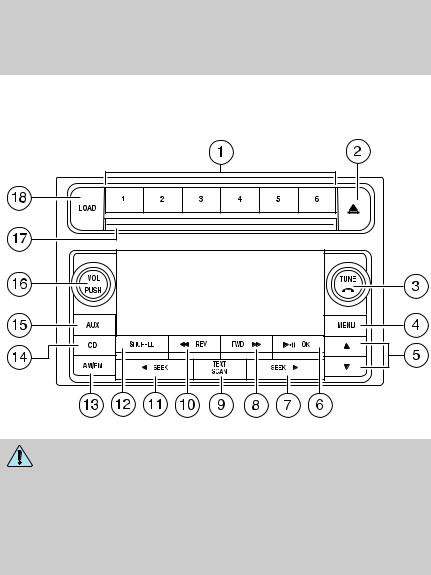
Entertainment Systems
AUDIO SYSTEMS
AM/FM In-dash six CD/MP3 satellite compatible sound system
WARNING: Driving while distracted can result in loss of vehicle control, accident and injury. Ford strongly recommends that
drivers use extreme caution when using any device or feature that may take their focus off the road. Your primary responsibility is the safe operation of the vehicle. We recommend against the use of any handheld device while driving, encourage the use of voice-operated systems when possible and that you become aware of applicable state and local laws that may affect the use of electronic devices while driving.
Accessory delay: Your vehicle is equipped with accessory delay. With this feature, the window controls, radio and moon roof (if equipped) may be used for up to ten minutes after the ignition is turned off or until either front door is opened.
30
2012 Navigator (nav)
Owners Guide, 1st Printing USA (fus)
